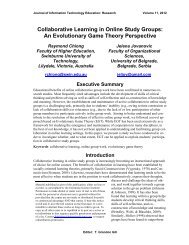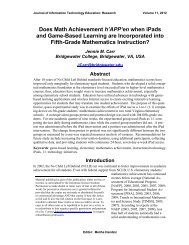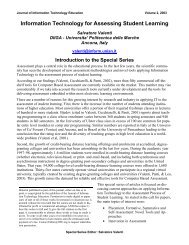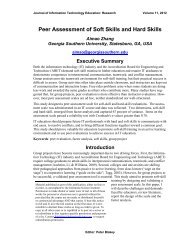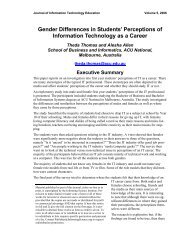Put Title Here Using Heading 1 Style - Journal of Information ...
Put Title Here Using Heading 1 Style - Journal of Information ...
Put Title Here Using Heading 1 Style - Journal of Information ...
You also want an ePaper? Increase the reach of your titles
YUMPU automatically turns print PDFs into web optimized ePapers that Google loves.
Thomas, Davis, & Kazlauskas<br />
thinking skills. With the correct scaffolding, students can be encouraged to work at the higher<br />
levels <strong>of</strong> Bloom’s revised taxonomy in both the knowledge and cognitive dimensions from the<br />
commencement <strong>of</strong> the first year <strong>of</strong> their IS studies.<br />
The next section expands on the concept <strong>of</strong> scaffolding to help students develop critical thinking<br />
skills.<br />
Scaffolding<br />
Holton and Clarke (2006, p.131) define scaffolding as “an act <strong>of</strong> teaching that<br />
(i) supports the immediate construction <strong>of</strong> knowledge by the learner; and<br />
(ii) provides the basis <strong>of</strong> independent learning <strong>of</strong> the individual.”<br />
They propose that it is only by the teacher providing the scaffolding that the independent learner<br />
is supported. Walton and Archer (2004) say that scaffolding provides learners with parts <strong>of</strong> the<br />
task that may be beyond their capacity initially. This allows learners to focus on the aspects <strong>of</strong> the<br />
task that they can manage, while still keeping an understanding <strong>of</strong> the task as a whole. Scaffolding<br />
is related to Vygotsky’s zone <strong>of</strong> proximal development (Rieber, 1987). Vygotsky believed<br />
that there are some problems that children can solve on their own and others that they will not be<br />
able to perform even with help. Between these two extremes, we find the problems that the child<br />
can solve with the help <strong>of</strong> the teacher, parent, or fellow students. This is true <strong>of</strong> university students<br />
too. Group activities and scaffolding provided by an expert in the form <strong>of</strong> guidance or support<br />
are therefore important in helping students to develop their ability to work independently<br />
(Jelfs, Nathan & Barrett, 2004).<br />
Holton and Clarke (2006) relate scaffolding in teaching to scaffolding in building construction.<br />
They say that workers are able to reach places that are otherwise inaccessible by placing a structure<br />
against the building to support them. By scaffolding students’ learning and cognitive processes,<br />
lecturers are able to stimulate new learning and enable students to reach new heights.<br />
Ramsden (2003, p123) maintains that “thoughtful teachers understand that highly structured initial<br />
experiences provide students with confidence and a sense <strong>of</strong> purpose; these experiences tend<br />
to make subsequent freedoms all the more fruitful and exciting.”<br />
Scaffolding should also make tasks meaningful by building on the knowledge and abilities that<br />
learners already possess (Walton & Archer, 2004). If scaffolding is implemented appropriately, it<br />
allows learners to gradually assimilate relevant principles and become independently responsible<br />
for their own learning (Sharma & Hannafin, 2004). As the students progress in their learning, the<br />
scaffolding provided by the teacher is removed, but the cognitive processes learnt should remain,<br />
enabling students to apply their learning and cognitive skills independently to new problems.<br />
Scaffolding through Questioning or Prompting<br />
One method <strong>of</strong> scaffolding is through the use <strong>of</strong> questioning or prompting. Questions can be<br />
asked to identify the logic and/or the origin <strong>of</strong> an idea and to prompt the student into thinking<br />
about supporting or conflicting evidence or the implications <strong>of</strong> their ideas (Sharma & Hannafin,<br />
2004).<br />
When students first tackle a problem we might ask questions like:<br />
• What are the important ideas here?<br />
• Can you rephrase the problem in your own words?<br />
• Have you come across other problems that might help you solve this one?<br />
331



